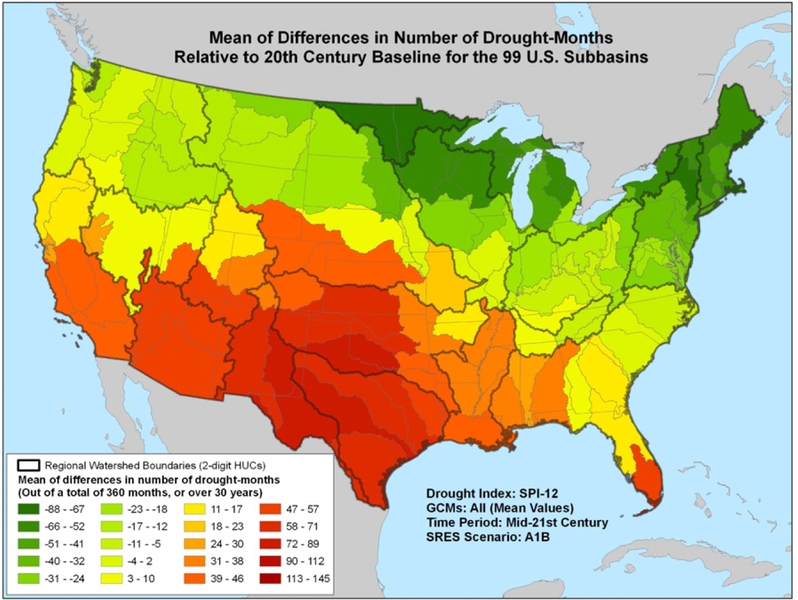The impacts of drought in the United States are estimated to cost an average of $6 to $8 billion per year. These impacts are likely to increase if drought risk throughout the United States is exacerbated by climate change, suggests a team of researchers led by Ken Strzepek of the MIT Joint Program on the Science and Policy of Global Change.
To analyze the effect of climate change on the frequency and intensity of droughts across the contiguous United States, the team looked at 99 water sub-basins, applying two different indices for drought to all 22 Intergovernmental Panel on Climate Change (IPCC) circulation models under three emissions scenarios (SRES). Results indicate that meteorological drought — which is based upon precipitation alone — will become more frequent in some parts of the U.S., such as the southwestern states, and less frequent in others. However, projections suggest that hydrological drought — which is based upon precipitation and temperature, which affects soil moisture — will increase across most of the country.
Given the comprehensive nature of the study, researcher Gary Yohe of Wesleyan University suggests that, “These results are robust across the economic drivers of climate change — as reflected in the alternative socio-economic scenarios (three IPCC SRES alternatives) — and the sensitivity of the climate to increased greenhouse-gas concentrations.” Additionally, the study finds that different definitions of drought generate different projections of drought distribution and frequency, pointing to the need to use multiple indices when studying drought risk.
Model projections indicate that the impact of climate change on drought frequency and severity will vary by region, with the southwestern U.S. and Rocky Mountain states likely to experience the largest increases in drought frequency. Additionally, results suggest that climate change may increase the longevity of droughts in many regions, causing events that would otherwise be mild droughts to become severe or even extreme droughts. This finding is important for policymakers who are considering adaptive responses, as current measures to manage droughts may be overwhelmed by large changes in the severity of future droughts. While the authors suggest that exploiting existing excess water storage capacity or reservoir yield may be able to ameliorate the negative impacts of increased drought, they caution that greater research is needed in this area to identify basins where such opportunities exist.
This study did not explicitly analyze the effect of greenhouse gas emissions mitigation on drought risk; however, results demonstrate that the impact of climate change on drought frequency will depend upon the level of future greenhouse gas emissions, providing evidence that lower carbon dioxide concentrations are associated with lower drought risk throughout the U.S. The research team, according to Yohe, “therefore offer preliminary support for the hypothesis that mitigation could reduce drought risk.”
To analyze the effect of climate change on the frequency and intensity of droughts across the contiguous United States, the team looked at 99 water sub-basins, applying two different indices for drought to all 22 Intergovernmental Panel on Climate Change (IPCC) circulation models under three emissions scenarios (SRES). Results indicate that meteorological drought — which is based upon precipitation alone — will become more frequent in some parts of the U.S., such as the southwestern states, and less frequent in others. However, projections suggest that hydrological drought — which is based upon precipitation and temperature, which affects soil moisture — will increase across most of the country.
Given the comprehensive nature of the study, researcher Gary Yohe of Wesleyan University suggests that, “These results are robust across the economic drivers of climate change — as reflected in the alternative socio-economic scenarios (three IPCC SRES alternatives) — and the sensitivity of the climate to increased greenhouse-gas concentrations.” Additionally, the study finds that different definitions of drought generate different projections of drought distribution and frequency, pointing to the need to use multiple indices when studying drought risk.
Model projections indicate that the impact of climate change on drought frequency and severity will vary by region, with the southwestern U.S. and Rocky Mountain states likely to experience the largest increases in drought frequency. Additionally, results suggest that climate change may increase the longevity of droughts in many regions, causing events that would otherwise be mild droughts to become severe or even extreme droughts. This finding is important for policymakers who are considering adaptive responses, as current measures to manage droughts may be overwhelmed by large changes in the severity of future droughts. While the authors suggest that exploiting existing excess water storage capacity or reservoir yield may be able to ameliorate the negative impacts of increased drought, they caution that greater research is needed in this area to identify basins where such opportunities exist.
This study did not explicitly analyze the effect of greenhouse gas emissions mitigation on drought risk; however, results demonstrate that the impact of climate change on drought frequency will depend upon the level of future greenhouse gas emissions, providing evidence that lower carbon dioxide concentrations are associated with lower drought risk throughout the U.S. The research team, according to Yohe, “therefore offer preliminary support for the hypothesis that mitigation could reduce drought risk.”






